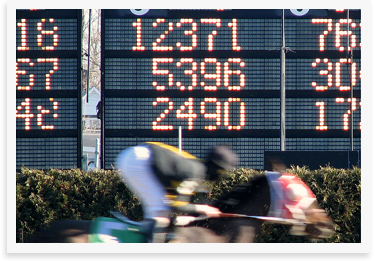AI and AutoML technologies are changing our approaches to most data-heavy occupations and how we deal with professional sports betting.
Past betting predictive models were either hand-written or computer-generated. In either case, these systems for professional gambling were work-heavy and required great user input.
However, developments in machine learning for betting on horses with no-code AI seem to alleviate all such issues. No longer are professional gambling models restricted to statistical experts.
How Does Betting on Horses with No-Code AI Work
The betting model uses Artificial Intelligence to predict statistically accurate outcomes for sporting events.
AI is a subtype of machine learning technology. While all ML systems aim to create auto-corrective models based on past databases, Artificial Intelligence aims to do so without the requirement of explicit programming.
In simpler terms, such programs take in past results of horse races and learn how to better approximate future outcomes without additional user input or a specific algorithm for generating results.
Further so, no-code services provide enhanced accessibility by simplifying the process of data input and utilisation of AI systems.
How Did Betting AutoML Come to Exist?
Machine learning implementations appeared out of a desire to effectively predict the most likely outcome of a sporting event.
Before automated models, most expert bettors tried to create handwritten statistical models with a certain degree of success.
In the end, no matter the approach, no model managed to predict the future constantly and accurately, albeit doing better than mere superstition, such as blowing on dice or crossing fingers.
The main difference of Auto-machine learning systems is that they would eventually self-improve, with more data.
Several No-Code AI Options Already Exist
Professional gamblers have flirted with AI implementations in the niche since IBM’s Deep Blue beat chess master Garry Kasparov in 1997. While the supercomputer was still far removed from being an AI model, the feat became proof of concept for the technology. Naturally, AI systems have only evolved since.
A Short History of Machine Learning in Gambling
Surprisingly, the first implementation of the kind appeared one year early, in 1996. M.C. Purucker of the University of Pittsburgh used a Neural Network Model to predict NFL results with 61% accuracy.
In 2003, Kahn of the University of Wisconsin-Madison updated Purucker’s network to achieve 75% accuracy in predictions for 205 NFL matches. However, in 2008, McCabe and Trevathan tested the same NN model on four different sports to obtain 67% accuracy.
The Best Results in Academia
More relevantly, in 2010, Elnaz Davoodi and Alireza Khanteymoori attempted to implement a machine learning method for horse betting. Although the program required ample time for training, its results achieved a staggering 77% accuracy. This attempt was to be the highest academically recorded result.
So, you may conclude, there is proof for the viability of betting on horses with no-code AI. The previous results obtained with the NN model are good enough to use for matched betting. All the while, the no-code AI programs are simple enough to be used by the average gambler and not just university teachers. You may not be surprised then that there has been one recorded instance of the use of AI machine learning for actual sports betting.
Betting on Horses with No-Code AI – A Real Example
The best practical example of the possibilities opened by machine learning for professional gambling occurred when betting expert Chris Rossi provided his thoroughbred results database for AI platforms Akkio.
Akkio is a user-friendly no-code auto-machine learning service. Thus, it was perfect for Rossi to try his hand at predicting horseracing results.
The pro gambler provided Akkio’s co-founder Jon Reilly 700 rows of training data describing all aspects of past races at the track. The aim of Akkio was then to compute the probabilities of various contending horses to finish first.
First Attempt
Rossi expected to attain two out of ten correct results. However, on race day, Akkio surprised the gambler by identifying six winners for the ten races.
The accuracy was even better since one horse predicted by the system to win did not participate in the race.
The implied probability computed by the platform mirrored the race time odds. However, Rossi did not place any bets in this event, wishing only to test out the platform’s potential. The conclusion seemed clear: betting on horses with no-code AI is financially viable.
Second Attempt
Rossi and Reilly repeated the process once more one week later, with a spreadsheet for the upcoming races at the Californian Del Mat Thoroughbred Club.
However, this time, the duo placed $10 bets based on Akkio’s highest probability of coming first predictions.
Unfortunately, the AutoML system only guessed one result correctly in the fifth race. However, given that Akkio correctly matched the post time odds, its predictions returned $136 for the overall $70 wagered sum.
For those keeping tabs, Akkio correctly picked seven winners across sixteen races. The result, however, amounts to a 43.75% success rate, which, by Rossi estimation, is ten points better than the general public’s.
So, by virtue of Akkio’s computation power, combined with Rossi’s database, we should conclude that betting on horses with no-code AI is advisable even.
One Interesting Example
Perhaps, we should not hurry to this conclusion. While AutoML systems are performant in predicting the correct results, bookies may have prepared against them.
There was one attempt in 2015 to predict the results of Dutch football tournaments. Interestingly, and differing from all other implementations, Tax and Joustra’s model also accounted for betting odds as variables. The predictive model, in the end, only obtained an accuracy of 54.7%.
However, the more interesting result came from the machine learning model that only used the betting odds. By taking only those as variables, the accuracy rose to 55.3%. As it was well observed, this discrepancy indicated that online bookies employed their own data science teams.
What Can We Conclude?
This fact may signal the death knell of independent gamblers getting an advantage by betting on horses with no-code AI. Bookies take note as AutoML technologies advance and peek their heads into the online gambling scene.
Sports betting companies, in turn, utilise their own machine learning implementations to formulate their odds. We may easily arrive at this conclusion from Akkio’s matching of race time odds.
Predictions for Betting on Horses with No-Code AI
Thus, while gamblers are just attempting to gain an edge with the technology, bookies may have already adapted their models with the help of machine learning.
We can speculate that in the future, sports betting will see gamblers betting on horses with no-code AI butting heads against bookies using their own AutoML algorithms in a self-correcting predictive model arms race.
Bookmakers also have the advantage of being able to restrict successful gamblers. In this case, even if you develop your model that performs better than the bookies’, they will eventually exclude you after a string of good predictions.










